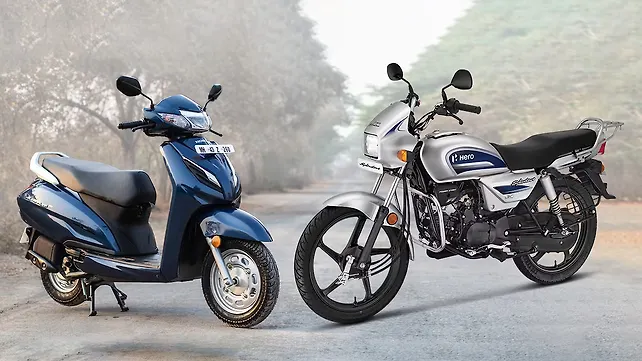
While September car sales touched new highs, the other important development during the month was that of HMSI (Honda Motorcycle & Scooter India) overtaking Hero MotoCorp in two-wheelers.
Since the time the two parted ways over a decade ago, a section of industry experts was then quick to write off Hero’s chances at survival. They were more than certain that it was only a matter of time before HMSI would emerge the leader of the two-wheeler arena.
These experts clearly underestimated Hero’s enormous strengths in retail and the power of the Splendor motorcycle brand. Both were key in ensuring that the company stayed comfortably ahead of HMSI even while the latter could not be faulted for not trying.
Hero continued to push on aggressively with its retail drive across rural India while its former Japanese ally banked on the Activa to fuel sales each month. There were times when this scooter brand surpassed the Splendor in certain months but it was a different ballgame when it came to dethroning Hero.
Over the years, the HMSI leadership did articulate its intent on more than one occasion of its desire to emerge the leader of the bike and scooter space but try as much as it did, it was proving to be a difficult task. The Splendor was just way too formidable and other rival manufacturers such as Bajaj Auto and TVS Motor also realised that when it came to the commuter segment, Hero was in a league of its own.
Is It A One-Off?
So, does September indicate a turnaround is finally happening in favour of HMSI or is this just a one-off setback for Hero? Not everyone is sure if this is indeed the case. “Right now, key markets for Hero such as Rajasthan, Uttar Pradesh and Bihar are not doing well and this explains why sales have collapsed as a result. Once they are back, things will change,” said a top executive of a two-wheeler company.
Another official is more brutal in his assessment. “It is pretty much the end of the entry-level commuter motorcycle story. People are seeking more premium products which other manufacturers are ready to offer,” he averred. Beyond this, it is his view that “Honda has tasted blood” and is now going to go flat out keeping Hero in check.
While the following months will show if September was a classic case of ‘one swallow does not make a summer’, there is no disputing the fact that rival two-wheeler companies do not consider Hero such a threatening force any longer. Sure, the numbers may come back on track but competitors believe that they are in a better position when it comes to being future-ready.
After all, the two-wheeler market is going through tremendous upheavals at this point in time with electrification being the calling card for all stakeholders. Bajaj Auto and TVS Motor already have their products out on the roads along with other hardcore electric players, while Hero is just about getting ready to launch its debut scooter offering under the Vida brand on Friday, October 7.

Beyond this, the company has recently announced its move to invest in US-based Zero Motorcycles for electric motorcycles and continues to have a strategic stake in Ather Energy, which has been the prime mover in the e-scooter space. Will the Vida brand make an impact that will propel Hero to the next level?
The answer will be clearer in the coming months except that it will have to take on more established electric scooter brands which have a clear head-start already. It is a million dollar question if the new breed of buyers are going to be swayed by the success of the Splendor and make a beeline for its manufacturer’s electric offering(s).
Hero also has a partnership in place with Harley-Davidson which was announced soon after the latter announced its decision to exit manufacturing in India. Some new products have been planned and it remains to be seen how this alliance pans out in the future.
Making An Impact With Electrics
Interestingly, Honda does not have an electric product for India yet though it is likely to have one out next year. Yamaha, likewise, has indicated that it is serious about bringing the Neos to India but the fact remains that local players like TVS and Bajaj have taken the lead and are keen on consolidating their presence even further.
The Japanese brands are not going to have an easy time catching up in the electric arena and industry observers believe this is equally true for Hero since it has been a late entrant to this game.
“Bajaj and TVS have been working relentlessly in this space and brands such as Chetak and iQube have already made a strong customer connect. These traditional players have shown what it takes to hold their own against the likes of Ather, Hero Electric, Ola and Ampere,” added a senior industry official.
TVS Motor, in particular, has been pulling out all the stops in its electric drive and making the most of leveraging technology in its alliances and acquisitions. The tie-up with BMW Motorrad will see significant strides in electric while the buyout of Norton Motorcycles is expected to take the global story to the next level. Further, with its focus on e-bikes through buyouts of two Swiss-based companies, TVS Motor has sent out a clear message of its intent to walk the talk on sustainability in the mobility space.
Bajaj Auto, likewise, will leverage its successful alliance with KTM (which includes Husqvarna) to push the envelope in electric both in India and across the world. It also has a strategic stake in Bengaluru-based Yulu which, along with Magna International, will see interesting iterations happening in the mobility arena. Further, Bajaj is now ready to take on Royal Enfield with its Triumph range of midsize motorcycles which are scheduled to debut from 2023 onwards.
Being Future Ready
It is this ‘future-ready’ approach that these two companies are focusing on in the coming years and which, in turn, raises the question of Hero’s invincibility going forward. Its rivals argue that the market leader has been a late entrant and will struggle to catch up with its rivals. Others do not agree and point out to the years after its divorce with Honda when Hero showed who the real winner was.
The Splendor doubtless has been a big factor in navigating its leadership script coupled with tremendous efforts on the retail side. It is, therefore, interesting that HMSI is now eyeing this rural space with its new 100 cc motorcycle next year. Honda observers say it will focus on technology as the main differentiator to woo buyers at an affordable price point. Will this move pay off and perhaps reignite the entry-level segment which is now showing signs of wear and tear?
Atsushi Ogata, Managing Director, President & CEO, HMSI, had told this writer in an earlier interview why the launch of this product was critical. “Just after I was assigned MD of HMSI, my task was to enhance market presence in India. I could then realise that the biggest weak point was our rural market presence compared to competitors,” he had said.
According to him, HMSI “could not connect with actual rural customer demand in terms of cost structure and pricing” and it was clear to him that “if we ignore the biggest market in India, the volume zone, it is not a good future for HMSI’s business”.
It was this reality that prompted Ogata to kick off talks with senior counterparts in Japan to ‘deconstruct’ the HMSI cost structure and carry out a feasibility study on how it could enter the rural market. Suppliers in India were also roped in for discussions to come up with a new cost structure that could help do the trick in meeting rural customers’ demand. If everything goes according to plan, the bike will make its debut next year.
The next tug-of-war between Hero and HMSI will then begin in the commuter space – which rivals believe is rapidly eroding – and it will be interesting to see if the new offering can take on the Splendor. For now, the Japanese auto brand will be pleased about its September showing except that experience has also shown that its former Indian ally is no pushover either.
Also Read:
Hero MotoCorp Gives Life To Its EVs By Unveiling New Brand Vida